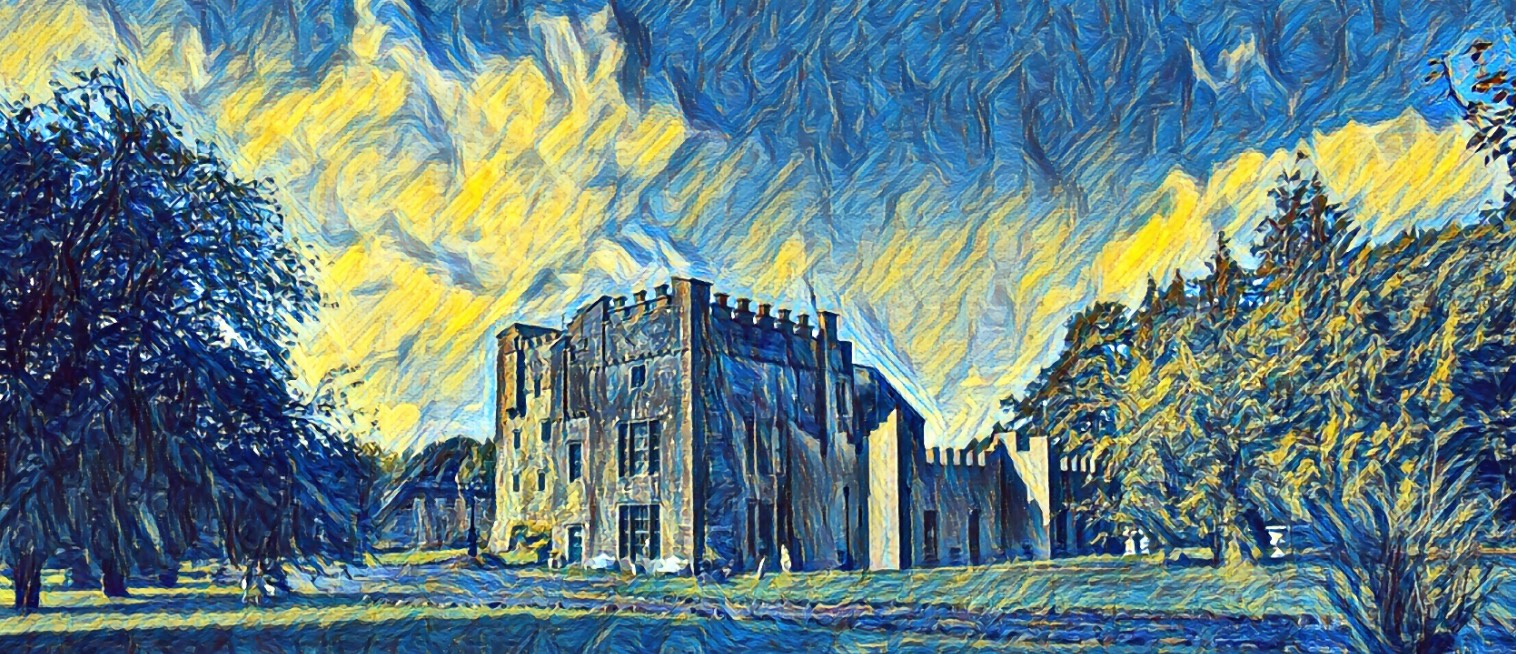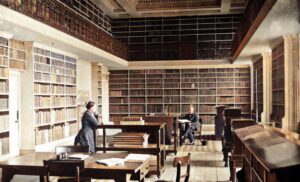Portlick Castle is located on the shores of Lough Ree, near Glasson in County Westmeath, Ireland. This historical site includes a late medieval tower house with subsequent Georgian and Victorian additions. It serves as an example of the architectural development in Ireland from the 12th to the 19th centuries. The castle’s position on Lough Ree has made it a notable landmark in the region, with a history that reflects broader social and political changes in Ireland. Its architecture and location provide insights into the strategic importance of such structures in medieval Ireland.
Contents
The Genesis of Portlick Castle
The foundation of Portlick Castle is associated with the Norman invasion of Ireland, a period that significantly altered the island’s historical and cultural landscape. The initial construction of the castle, a tower house, dates back to the 15th century, during a time of Norman expansion and consolidation of power in Ireland. This structure was typical of Norman military architecture, designed for defense and as a symbol of Norman authority.
The castle is linked to Sir Henry de Leon (later known as Dillon), a Norman knight who accompanied Prince John of England to Ireland following the successful conquests by the Earl of Pembroke, also known as Strongbow. De Leon was awarded extensive lands in the Westmeath area for his service, which included the lands on which Portlick Castle was built. This early structure was strategically important, located along Lough Ree, an essential route for transport and communication during the medieval period.
In its early years, Portlick Castle played a significant role in the Norman strategy of securing and controlling newly conquered territories in Ireland. It symbolizes the transition in land ownership and the establishment of Norman governance in the region. The castle’s history, from its initial construction to its occupancy by the Dillon family and later by others, reflects the changing political and social dynamics in Ireland over several centuries.
Architectural Evolution
Portlick Castle’s architectural development provides a clear window into the evolution of building styles and functions in Ireland from the medieval period through the 19th century. The core of the castle is the original medieval tower house, constructed in the 15th century. This structure is characteristic of the period’s military architecture, with thick stone walls and narrow window openings designed for defense. The tower house is a square, stone-built structure, comprising four storeys, which was typical for tower houses built across Ireland during the medieval era.
In the 18th century, a significant addition was made to the castle in the form of a Georgian wing. This two-storey extension represents the architectural tastes of the Georgian era, characterized by symmetry and classical proportions. The Georgian wing added a new residential dimension to the castle, reflecting a shift from purely defensive structures to more comfortable living spaces. The design features of this period often included larger windows than those of the medieval period, allowing for more light, and decorative elements inspired by classical antiquity.
The Victorian era brought further changes to Portlick Castle with the addition of a Victorian tower in the 19th century. This addition underscored the period’s fascination with medieval and Gothic styles, often referred to as Gothic Revival architecture. The Victorian tower would have included features such as pointed arches, ribbed vaults, and perhaps ornate stone carvings, which were popular in Victorian interpretations of medieval architecture.
Other significant renovations and additions throughout the castle’s history likely included updates to the interior spaces, modernization of living facilities, and possibly the incorporation of new defensive features before the transition to more peaceful times. Each phase of construction and renovation at Portlick Castle not only added to the physical structure but also reflected the changing needs, tastes, and technological advancements of the times.
The Dillon Dynasty
The Dillon family’s connection to Portlick Castle traces back to their Norman origins, specifically to Sir Henry de Leon, a Norman knight granted lands in the Westmeath area after the Norman invasion of Ireland. The surname evolution from De Leon to Dillon signifies their integration into Irish society while retaining their Norman roots. The construction of Portlick Castle in the 15th century established the Dillon family as a significant landowning and feudal power in the region, serving as their principal residence and the administrative center for their estates.
As one of the leading Anglo-Norman families in Ireland, the Dillons’ social and political standing was closely tied to their allegiance to the Crown, influencing their control and governance of local lands. Portlick Castle, as a result, played a crucial role in their military, administrative, and economic activities, reflecting the broader socio-political landscape of medieval Ireland.
The Dillon family’s tenure at Portlick Castle saw them navigating the complexities of Irish and English rule, utilizing the castle as a base for overseeing agricultural production, trade, and local justice. Their management of the surrounding estates from the castle contributed to their prominence in the region.
Architectural contributions by the Dillons to Portlick Castle over the centuries reflect the changing needs and preferences of the family, transitioning from medieval fortifications to include domestic improvements characteristic of Georgian and Victorian eras.
The end of the Dillon family’s association with Portlick Castle occurred in the late 17th century following the Williamite wars, leading to the confiscation of their lands. This marked a significant shift in the castle’s ownership and the conclusion of the Dillon dynasty’s direct involvement with the property. Their historical connection to Portlick Castle remains a key part of the site’s history and heritage, illustrating the family’s role in the region’s Norman legacy.
The Smyth Era
The transition of Portlick Castle to the Smyth family occurred in the early 18th century, marking a new chapter in the castle’s history. After the Dillon family lost possession of the castle due to political changes following the Williamite wars, the property was eventually acquired by the Reverend Robert Smyth in 1703. This acquisition marked the beginning of a long tenure by the Smyth family, during which the castle underwent significant changes, both architecturally and in terms of its role within the community.
Under the Smyth family, Portlick Castle saw the addition of the Georgian wing, aligning with the architectural trends of the 18th century. This new wing was characterized by symmetry, classical proportions, and larger windows than those of the medieval structure, reflecting a shift towards more domestic and less militaristic uses of the property. The Georgian wing added a new level of comfort and modernity to the castle, making it suitable for residential purposes and social gatherings.
One of the most significant events during the Smyth era was the fire in 1861, which caused extensive damage to the castle. The fire led to the loss of valuable possessions and necessitated a major restoration and rebuilding effort. In response to this disaster, the Smyths undertook significant reconstruction work, which included the addition of a Victorian tower. This construction effort not only restored the damaged parts of the castle but also introduced Victorian architectural elements, such as Gothic Revival features, further diversifying the architectural character of Portlick Castle.
The Smyth family’s contributions to Portlick Castle extended beyond architecture. They were responsible for maintaining the estate and engaging in local affairs, contributing to the social and economic well-being of the surrounding community. Their tenure encapsulated a period of relative peace and prosperity, allowing for the castle’s transition from a medieval fortress to a Georgian and Victorian-era country house.
The Smyth family remained at Portlick Castle until the mid-20th century, leaving behind a legacy of architectural innovation and community involvement. Their era saw the castle adapting to changing times, with each architectural addition reflecting contemporary tastes and the family’s response to events such as the 19th-century fire.
Restoration and Modern History
From around 1953 to 1970, the castle was home to Finn Thor and Tora Hannevig and their family. This era saw the introduction of electricity and laundry facilities, among other modernizations, indicating the castle’s ongoing adaptation to the needs of its inhabitants. The Hannevig family’s tenure is well-documented through extensive family photographs, capturing the castle’s lived-in warmth and vitality. Finn Thor Hannevig, in particular, is remembered for his frequent mentions of the “Blue Lady,” a spectral figure said to roam the castle, adding a layer of mystique and continuity with the past. Both Finn Thor and Tora Hannevig were laid to rest in the local Benown Church (Church of Ireland) Graveyard, marking their lasting connection to the area and its history.
In the late 1980s, Luke Whitington, an Australian poet and art patron with a background in restoring historical buildings in Italy, acquired the property. Whitington embarked on an extensive refurbishment program aimed at restoring the castle to its former glory while preserving its historical features. This work included structural repairs, the installation of modern amenities, and the careful restoration of the castle’s Georgian and Victorian additions. Through these efforts, Portlick Castle was transformed into a habitable residence once again, with its historical integrity intact.
In the early 21st century, Portlick Castle transitioned to new ownership when it was sold to an Irish-American family from California. This sale marked a new chapter in the castle’s history, opening possibilities for its use as a private residence and potentially for public engagements, such as tours or cultural events. The castle’s role in contemporary culture has since been defined by its historical significance and its ability to serve as a link between Ireland’s past and present.
Ghosts and Legends
Portlick Castle, like many historic estates, is enveloped in local legends and tales of hauntings, the most notable of which involves the “Blue Lady” ghost. This spectral figure is said to roam the castle and its grounds, often associated with stories of tragedy or unrequited love from the castle’s long history. The legend of the Blue Lady is a common motif in Irish folklore, representing the castle’s rich narrative past and its place in the local imagination.
These ghost stories and legends add a layer of mystique to Portlick Castle, enriching its cultural significance and attracting interest in the property’s history and restoration. While the origins of these tales are often rooted in local folklore and anecdotal accounts, they contribute to the castle’s identity and its allure as a historical site. Whether believed to be true or simply part of the castle’s folklore, the stories of hauntings and the Blue Lady continue to fascinate visitors and locals alike, underscoring the castle’s role in Ireland’s rich tapestry of myths and legends.
Portlick Castle Today
Portlick Castle, having undergone extensive restoration in the late 20th century, currently serves as a private residence. The castle’s transition to new ownership in the early 21st century by an Irish-American family has opened up possibilities for its future role, both in the local community and as a cultural heritage site. While primarily a private dwelling, there has been discussion about making the castle and its grounds accessible to the public for tours and cultural events. This potential public accessibility could further enhance the castle’s significance, providing a direct link to Ireland’s medieval, Georgian, and Victorian architectural history and cultural heritage.
In the local community, Portlick Castle remains an emblem of historical significance, embodying centuries of architectural evolution and the socio-political changes in Ireland. Its preservation and continued use underscore the importance of maintaining historical sites not only for their architectural value but also for their role in educating and connecting communities to their past.
The Estate and Surrounding Lands
Portlick Castle is set within an estate that features extensive grounds, including walled gardens, wooded areas, and pasture land. The walled gardens, a characteristic feature of Georgian-era landscapes, offer a secluded and historically inspired retreat, carefully maintained to reflect gardening styles of the past. Beyond the walls, the estate expands into lush wooded areas and open pasture lands, contributing to the biodiversity of the region and providing habitat for local wildlife.
The estate’s location on the shores of Lough Ree enhances its natural beauty and offers numerous leisure pursuits for the local community and visitors. The lake, one of Ireland’s largest, is a popular spot for fishing, boating, and bird watching, making the castle’s surroundings a destination for outdoor enthusiasts and nature lovers. The natural beauty of Lough Ree and the rich history of Portlick Castle combine to create a unique and valued landscape, appreciated for both its recreational opportunities and its cultural heritage.






